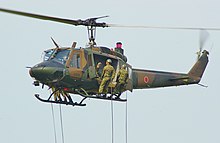The United States Armed Forces are the military forces of the United States. The armed forces consists of six service branches: the Army, Marine Corps, Navy, Air Force, Space Force, and Coast Guard. All six armed services are among the eight uniformed services of the United States.

A military aircraft is any fixed-wing or rotary-wing aircraft that is operated by a legal or insurrectionary military of any type. Military aircraft can be either combat or non-combat:

The Army Air Corps (AAC) is a component of the British Army, first formed in 1942 during the Second World War by grouping the various airborne units of the British Army. Today, there are eight regiments of the AAC as well as two Independent Flights and two Independent Squadrons deployed in support of British Army operations around the world. Regiments and flights are located in the United Kingdom, Kenya, and Canada. Some AAC squadrons provide the air assault elements of 16 Air Assault Brigade through Joint Helicopter Command.

In military tactics, close air support (CAS) is defined as aerial warfare actions—often air-to-ground actions such as strafes or airstrikes—by military aircraft against hostile targets in close proximity to friendly forces. A form of fire support, CAS requires detailed integration of each air mission with fire and movement of all forces involved. CAS may be conducted using aerial bombs, glide bombs, missiles, rockets, autocannons, machine guns, and even directed-energy weapons such as lasers.
A group is a military unit or a military formation that is most often associated with military aviation.
The title flight officer was a military rank used by the United States Army Air Forces during World War II, and also an air force rank in several Commonwealth countries, where it was used for female officers and was equivalent to the rank of flight lieutenant. The term flight officer is sometimes used today to describe job title positions as aircrew members.

The 1st Marine Aircraft Wing is an aviation unit of the United States Marine Corps that serves as the Aviation Combat Element of the III Marine Expeditionary Force. The wing is headquartered at Camp Foster on the island of Okinawa, Japan. Activated in 1940, the wing has seen heavy combat operations during World War II, the Korean War, and the Vietnam War.
In the United States Marine Corps, a Marine air–ground task force is the principal organization for all missions across the range of military operations. MAGTFs are a balanced air–ground, combined arms task organization of Marine Corps forces under a single commander that is structured to accomplish a specific mission. The MAGTF was formalized by the publishing of Marine Corps Order 3120.3 in December 1963 "The Marine Corps in the National Defense, MCDP 1-0". It stated:
Assault Support is one of the six functions of United States Marine Corps aviation and comprises those actions required to airlift personnel, supplies or equipment into or within a battle area by helicopters or fixed-wing aircraft. It provides the Marine Air-Ground Task Force commander the ability to concentrate his strength against selected weaknesses using speed and surprise. It also provides operational and tactical mobility as well as logistics support to the Marine Air-Ground Task Force. It is used to focus combat power at the decisive place and time to achieve local combat superiority.
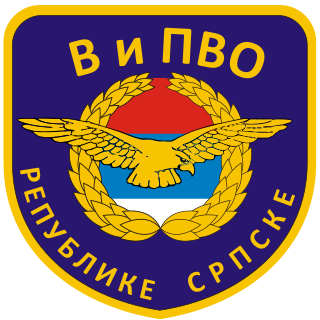
The Republika Srpska Air Force was the air force of Republika Srpska and was used primarily during the Bosnian war. In 2005, it was integrated into the Armed Forces of Bosnia and Herzegovina. SFOR still plays a large role in Bosnia and Herzegovina, which consists of the Federation of Bosnia and Herzegovina and Republika Srpska. Under the leadership of one president, the ministry of defense of both entities merged into one single ministry of defense with one chief of joint staff commanding both Air Forces. In 2004 there was again a restructuring of the armed forces, bringing the number of Air Force personnel down to 4,000. Next to the command, the 1st Regiment V i PVO consists out of a platoon, a radar battalion, artillery rocket ADF battalion, AF logistics battalion and aviation assets, a Fighter Bomber Squadron and Mixed Helicopter Squadron. In 2006 the Air Force of Republika Srpska was disbanded.
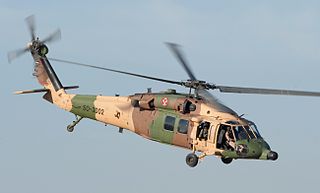
A military helicopter is a helicopter that is either specifically built or converted for use by military forces. A military helicopter's mission is a function of its design or conversion. The most common use of military helicopters is transport of troops, but transport helicopters can be modified or converted to perform other missions such as combat search and rescue (CSAR), medical evacuation (MEDEVAC), airborne command post, or even armed with weapons for attacking ground targets. Specialized military helicopters are intended to conduct specific missions. Examples of specialized military helicopters are attack helicopters, observation helicopters and anti-submarine warfare (ASW) helicopters.

The United States Army Aviation Branch is the administrative organization within the United States Army responsible for doctrine, manning and configuration for all army aviation units.
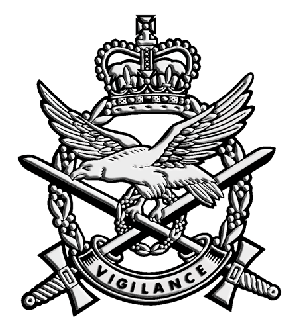
Australian Army Aviation (AAAvn) is a corps of the Australian Army. It was formed on 1 July 1968. The motto of the Australian Army Aviation corps is Vigilance.
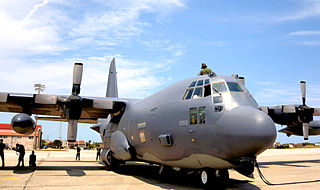
The 102nd Rescue Squadron is a unit of the New York Air National Guard 106th Rescue Wing stationed at Francis S. Gabreski Air National Guard Base, Westhampton Beach, New York. The 102nd is equipped with the HC-130J Combat King II transport aircraft.
Combat arms are troops within national armed forces who participate in direct tactical ground combat. In general, they are units that carry or employ weapons, such as infantry, cavalry, and artillery units. The use of multiple combat arms in mutually supporting ways is known as combined arms. In some armies, notably the British Army and Canadian Army, artillery and combat engineer units are categorized as combat support, while in others, such as the U.S. Army, they are considered part of the combat arms. Armored troops constitute a combat arm in name, although many have histories derived from cavalry units.
The Pace-Finletter MOU of 1952 was a memorandum of understanding (MOU) signed on 4 November 1952 between Secretary of the Air Force Thomas K. Finletter and Secretary of the Army Frank Pace that removed the weight restrictions on helicopters that the United States Army could use. It also widened the range of tasks the Army's helicopters could be used for. However, it also created an arbitrary 5,000 pound weight restriction limit on the Army's ability to fly fixed-wing aircraft. As a result, the U.S. Army today is dependent upon the United States Air Force to purchase and man fixed-wing ground-attack aircraft to fulfill close air support missions.
"...that established a fixed wing weight limit of five thousand pounds empty, but weight restrictions on helicopters were eliminated ..."
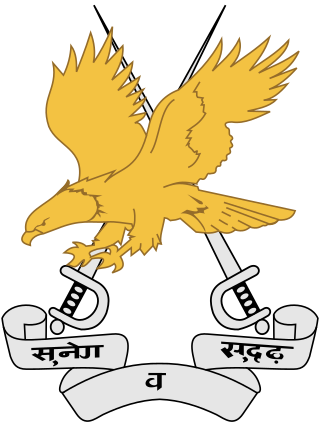
The Army Aviation Corps (AAC) is the youngest arm of the Indian Army, being formally designated on 1 November 1986. The Army Aviation Corps units are designated as Squadrons. Each squadron generally consists of two Flights. Reconnaissance (Recce) and Observation flights might be part of squadrons or operate independently. The latter do not have a parent squadron and are designated by an (I) in their name.

Mainz-Finthen Airport(German: Flugplatz Mainz-Finthen) is an airport in Germany, located about 3 miles (5 km) southwest of Mainz and approximately 320 miles (510 km) southwest of Berlin.

A squadron in an air force, or naval or army aviation service, is a unit comprising a number of military aircraft and their aircrews, usually of the same type, typically with 12 to 24 aircraft, sometimes divided into three or four flights, depending on aircraft type and air force.
The Department of Air Training was originally a part of the U.S. Army Ground Force's Field Artillery School at Fort Sill, Oklahoma. It trained Forward Observer pilots to act as organic spotter units for U.S. Army artillery battalions and brigades. The pilots were eventually not just used to adjust artillery fire, but to support naval gunfire, direct bombing missions, perform aerial reconnaissance, conduct medical evacuations, and perform liaison and command and control duties as well.

